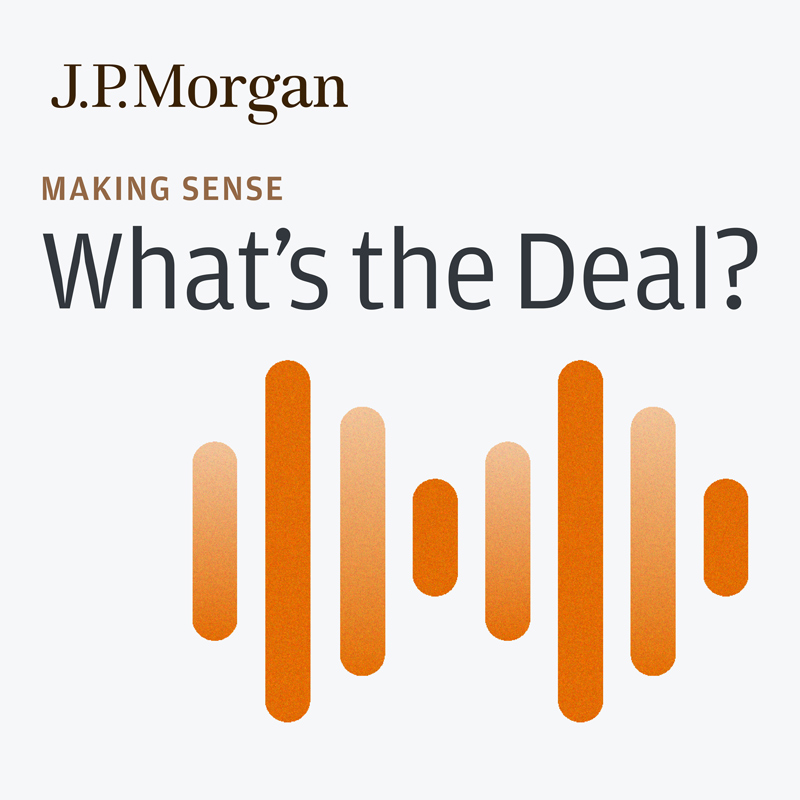What’s The Deal? | Powering growth through partnership: Mid-Cap Investment Banking & Financial Sponsors
[MUSIC]
John Richert: Hi. You're listening to What's the Deal? Our investment banking series here at J.P. Morgan's Making Sense podcast. I'm your host, John Richert, Head of J.P. Morgan's Mid-Cap Investment Banking team. I'm excited to be joined by my colleague, John Burns, Head of J.P. Morgan's Mid-Cap Financial Sponsors Group, as we've just wrapped up J.P. Morgan's second annual Mid-Cap Financial Sponsors Conference in Austin. John, welcome to the podcast.
John Burns: Thank you for having me, John Richert and I greatly appreciate the opportunity.
John Richert: I'm really looking forward to giving our listeners a glimpse into how we work together and our outlook on the market, especially related to midcap and mid-market trends in financing, M&A, and sponsor-backed transactions. John, the Mid-Cap Financial Sponsors Group, formerly Middle Market Financial Sponsors Group, was formed under your leadership within the last five years. But you've been at the firm for over 27 years now. Can you share a brief overview of your background and role at JP Morgan and what your team has focused on?
John Burns: So, as you said, 27 years at J.P. Morgan, all in investment banking, industry coverage in airspace and defense, and about the last decade exclusively focused on financial sponsors. A big chunk of that in our large cap financial sponsor coverage group. In essence, what we're doing with our midcap financial sponsors group is just focusing more intently on smaller financial sponsors. The goal for our group is to frankly attack the white space of midcap investment banking, basically getting PortCos, instead of waiting until they're large, to start covering these PortCos and the sponsors as these assets are small to basically start the flywheel of repeat business with these companies. It's a white space for the investment bank. It's an area of growth for our commercial bank also as we maintain the relationships with these smaller commercial banking clients as they are sold to financial sponsors. As I said, it's a great area of strategic focus across the firm and it's a great opportunity for me to use some of the experience that I've had throughout the years to help lead this effort of growth into white space for J.P. Morgan.
John Richert: I think you touched on one of the trending words that we talk about today, flywheel and incumbency. Would you mind talking a little bit about how the J.P. Morgan strategy around financial sponsors, particularly middle market sponsors, has changed over the years, what our view was of when we thought we would want to come in and sell a company versus where it is today? And what is that virtuous lifecycle that our CEO, Jamie Dimon’s, challenged us all to adhere to with our clients?
John Burns: Great question, John. In essence, in my decade in the large cap financial sponsor group, we only attacked [inaudible 00:02:44] to a certain extent when they got into the 50 to $100 million EBITA range. And in essence, in the syndicated debt market, that really sort of starts at 50 million in EBITA also. So, as part of Jamie Dimon's push into middle market companies and middle market sponsors, the significant push is to have lending available for under $50 million in EBITA and that's why we set aside, started out with 10 billion in capital for direct lending, for example and that's growing. But then as you well know, John Richert, a big part of covering sponsors is to have industry-focused investment bankers focused on assets that are under $2 billion enterprise value, or under $50 million in EBITA. So, if you've got the investment banking focus lined up, and additionally, the better lending to our financial sponsors, then with intent sponsor-focused coverage showing them more ideas, looking at more debt deals for them, doing more debt deals for them, and then bringing in the appropriate industry-focused coverage out of the midcap investment bank, frankly, has led to the early stages of success that we've seen.
John Richert: Yeah, that makes sense. And the other thing that I think people don't fully appreciate and- and would be good for you touch on a little bit is the number of middle market sponsors that are out there, the pace at which they're fundraising and going from fund one, two to three, and the amount, as we look at inside the middle market commercial bank, just the number of portfolio companies that are out there that by my estimate has grown almost at 10,000 names at this point and then 8% CAGR since 2001 with no sense of abating. But, I think you'd probably have a better view on just the addressable marketplace of middle market sponsors that's out there.
John Burns: Another great question, John. So, in our midcap financial sponsors group, we have about 10 managing directors focused on finger level coverage at midcap sponsors. We are tracking about 1,200 midcap sponsors. I would say we have intense coverage of about 400 midcap sponsors. And as you alluded to, this number is frankly increasing every day. The dynamic of a partner at a large cap sponsor spinning out and starting his own fund, it's frankly a great way for us to grow our coverage. That's one example. Additionally, although 2023 was a tough fundraising year for sponsors, I think we've already seen the beginning of this year more launches of funds, a little bit more open liquidity for people. And you threw out the number of 10,000. The number that I use, which J.P. Morgan is getting better at tracking, upwards of 11,000 PortCos in our system that we are tracking right now.
John Richert: That's an amazing number. John, you've used the word, attack, a couple of times here. Why don't you enlighten the audience a little bit about your military background?
John Burns: Yes, I have used the word, attack, and it is part of my previous background. So, I went to the Naval Academy undergrad and then served for five years in nuclear submarines. And it is part of my fiber to focus on winning with a team and that's been instrumental frankly in my career and also in this role to attack the midcap sponsors area. And frankly, it's great to be at a firm which has such a focus on military and military spouse employment. And now to turn the tables a little bit. John, why don't you discuss the midcap investment banking team, formerly the Regional Investment Banking Team, and share how your team has evolved over the past few years, especially in response to market changes and client needs.
John Richert: Happy to. And this will give you a moment to recover and take a deep breath. I've been asking you a bunch of questions. As I talked about earlier in the name changes as we've gone through this merger with the commercial bank and the investment bank, which I think is an outstanding outcome for all of us and the combined leadership under Doug Petno and Filippo Gori. We changed our name to Mid-Cap Investment Banking as a reflection of the evolution of the group that we used to call, Regional Investment Banking. And similarly, to be focused on the market that you are and the partnership that we have there.
The original idea 10 years ago when we founded the group was we have this amazing investment bank, this amazing commercial bank that's growing, what is our market share with our commercial banking clients? And at the time, it was kind of in a five, 6% area. And we've grown that into the teens at this point. And what's important about how we did that was take bankers who easily could've stayed in an industry team, but for reasons to them, they find working with more middle market companies to be a bit more interesting. Get into the regions mirroring the cities, the main cities that the commercial bank is in. Delving in and becoming a fabric of that community. Understanding and getting into companies early, calling on them often and building a successful corporate business. And that was the model for the first five or six years as we started in four cities, New York, Atlanta, Chicago, and Dallas. And over the past 10 years, we've grown that to 13 cities in the U.S. and Canada in Toronto. So, we've covered the nation at this point and we're looking to probably add into Miami and Seattle. And then I think we're done with the regional growth. But as we pivoted to this focus on middle market sponsors back in 2019 and 2020, you touched on this a little bit, there were four things that we had to do.
We needed to create a direct lending platform, which Jamie funded for us and gave us the balance sheet capacity to go do. We needed to focus on us sponsoring an A team, which we've built out. We needed to really ramp up our sponsor coverage, and creating your group was absolutely essential to what we needed to do to win. And the last piece was kind of moving from what was a generalist-type model, that was mostly focused on industrial and consumer retail companies, into an industry-focused model that compliments our regional focus. And to that end, we have six industry teams that compliment our global industry teams inside midcap and investment banking, as industrials, consumer retail and business services. Tech, healthcare, which is predominantly healthcare services. Meeting and communications, and energy, and natural energies, and renewables with much more of a focus on renewables. And that's now at 35 verticals that we cover inside of midcap and investment banking. So, I think that evolution is what's allowed us to grow our [inaudible 00:09:57] North American IB fees from 5% five years ago to 13% today. And again, that market share that we have has gone from mid single digits to low double digits with a goal over the next five years to increase it by 500 more basis points.
John Burns: Do you have any interesting case studies that would exemplify the strategy?
John Richert: Great question with that one, John. About three years ago, we sold a company called J&J to Arlington Capital Partners. And John, there are three things that were first about this deal. This is our first roundtrip exit from the flywheel that we've spoken about. This was our first, uh, use of the direct lending balance sheet, uh, that Jamie put in place for us. And third, it was the first transaction that we had done with Arlington Capital Partners, who has become a valued client of the firm. This was a longtime client of J.P. Morgan in Texas in the Commercial Bank. Like many family-owned businesses, it was not for sale until it was. Our commercial bank identified the opportunity, brought in Dave Kulsa and Mark Marengo from our government and defense contracting team to win a competitive bake-off. We sold it to Arlington Capital, which was a sponsor that we had not worked with a lot previously. Three years later, we were awarded the mandate as the incumbent seller of the business to Arlington Capital. And sold it for just under a billion dollars to Excenture. Today, what that also has done with the help of Peter Engel and others around Arlington Capital is led to three more transactions that would not have happened had we not sold that business three years ago that had been a Chase client for over 40 years.
John Burns: And John, that's the perfect poster child frankly for what we're trying to do, sell it to a sponsor, sell it to another sponsor, or sell it to a strategic in that case, or take it public.
John Richert: And to me, that's the great thing about J.P. Morgan, as we've expanded all these sponsor relationships, that really gives us a whole new market that we understand better. We've always had this great global banking presence with our outstanding industry partners across North America, EMEA, Latin America and Asia-Pacific. But now, we're kind of taking those two things and putting it together. And I don't think there's anybody else that can do it the way that we have. And that kind of leads to the point of that new focus on the midcap sponsors. You just wrapped up our second conference in Austin on the midcap sponsors. Would love to just kind of get some insights of what were your takeaways from that conference that are going to have the most significant impact on the market going forward.
John Burns: Great. As you said, our second annual conference just occurred in Austin.
John Richert: Keyword is annual. We are running it back and making it even better.
John Burns: We're already planning next year's conference, amazingly. So, this year's conference, just a couple of data points. We had 75 midcap financial sponsors represented and about 40 companies. 40 companies presented to those financial sponsors, potential partners in the future for those financial sponsors. As I look back when I started in this role, there were some doubts from clients about, "Are we really in this? Are we dedicated to this? Just over one year we've grown this conference by about double, when you look at the number of presenting companies and we're gonna grow it further next year. It's just another proof point that J.P. Morgan definitively in the middle market, the midcap market, focused on financial sponsors. We just have to keep up that intensity not only with the deals and the wins that we're doing, but with these sort of services that we're providing to this midcap sponsor ecosphere, such as this conference. Another takeaway for me, we had hundreds of meetings, J.P. Morgan with financial sponsors at the conference. I sat in on dozens of them. Sponsors want to do business with J.P. Morgan. And frankly, the feedback from clients about our efforts has been excellent.
John Richerts: Many doubts. So, that's consistent with what my bankers were always hearing when we would go to those initial meetings. They're like, "Okay. This is J.P. Morgan just showing up. But as soon as the shiny IPO market opens back up, we won't see you anymore."
John Burns: And frankly, John Richert, we're breaking down some of that disbelief just through intensity, through effort, through examples of just growing this very intense conference for our clients. So, it's moving in the right direction and they want to do business with them. What I tell people is, our goal isn't to beat all the direct lenders or beat every boutique for the sell sides, but over a decade, we want to get more than our fair share of business, doing it in the right long-term relationship focused J.P. Morgan manner, and it resonates with a client. One of the examples of that resonance is, you know, at the beginning of '23 we had seven sell sides in pipeline. And fast-forward to June 2024, we have 38 sell-sides in backlog. So, we're starting to see the momentum build. People want to do business with us. With the strategic focus that we have, it's just gonna continue growing and thriving.
John Richert: I think it's a great business that you've put together. You've created much more headcount, which was needed to go after it. My teams' now up to almost 150 bankers. And I think when sponsors and clients just see the resources that J.P. Morgan has put against this effort, it helps break down that notion that these deals are too small for J.P. Morgan, you're not focused on the sub $1 billion sell side. And is categorically not true. We want those. We want to have the lifetime value of our clients, whether it's on my team, your team, the Commercial Banking team, the Private Bank, it is a great synergy that works together across all lines of business here at J.P. Morgan.
John Burns: It does. It's here to stay. And to highlight or to add to that point you just made, I think of two years ago we did a sell side pitch with a client. It was our first sell side at bat with this specific client. We did a great job, but we lost. And part of the reason we lost was that lack of faith that we were really intensely focused in the middle market. Fast-forward, we just won a sell side mandate from the client. And over the intervening two years, we just covered that client intensely, proving that we were in the market, breaking down those barriers, those doubts and that's our 38th sell-side win within the mid-cap sponsor effort.
John Richert: Keep it going. Keep it going. So look, kind of bringing our conversation to an end here, as you think about the back half of 2024 going into '25, where do you see the greatest opportunities for growth and investment in the mid-cap and middle market spaces over that time period? And what are the strategic priorities that you're focused on to capture these opportunities?
John Burns: So John, you highlighted this earlier, but the partnership with the midcap investment bank is absolutely vital to our success. We've got a lot of very seasoned investment bankers now focused on this $2 billion enterprise [inaudible 00:18:14] below. As I say, internally and externally, the focus of our group is to prioritize sell side M&A. It is the hardest thing to win from a sponsor. And the other products that sponsors usually deal with, such as debt or equity, et cetera, will come along as we focus on the sell side M&A. M&A has picked up this year significantly, probably not as quickly for financial sponsors as people had hoped. So, my strategic focus is more long-term, just to continue the intense coverage, continue to sort of wrap our arms around all of our clients, get deeper into their portfolios. And as the M&A market turns, we will win more than our fair share of opportunities to sell assets in what is sort of a market that feels like it's moving up and to the right.
John Richert: It does feel that way. And I think if you go back to December after the very quiet 2023 in the middle market and with sponsors, as a whole, we did feel that it probably would be higher. Again, our midcap M&A business was up 48% last year, versus the overall M&A business that was up 2%. So, the middle market is still remaining robust. If you look at this year, middle market M&A is up 10%. Over the year-over-year period, up to, 213 billion year to date. Strategic is the majority of that, 160 versus 54 for sponsors. But that sponsor business is still up 5% year-over-year and strategic business is up 14% year-over-year. But really feels like it's starting to accelerate right now just based on the number of mandates we're winning and things that we're starting to bring to market. So, I think one way we can end this podcast is in a positive mood, that I think we feel great about the financing markets. We feel good about where the M&A markets are going, the equity markets remain strong and let's just have fun with this election season. See what happens next.
John Burns: Thank you, John Richert, for the opportunity to talk about what we have going on. And again, thank you for the partnership with your group.
John Richert: Absolutely. So, to recap, we had a great conversation today on the latest insights for midcap financial sponsors with John Burns. A little bit of insight coming out of the financial sponsor conference that he ran this year, which hopefully some of our listeners will be joining us next year. John, thank you so much for taking the time to speak with me today. And thank you to our listeners for tuning in to another episode of What's the Deal? We hope you enjoyed this conversation and be sure to tune in to our upcoming episodes. I'm your host, John Richert. Until next time, goodbye.
Voiceover: Thanks for listening to What's the Deal? If you've enjoyed this conversation, we hope you'll review, rate and subscribe to J.P. Morgan's Making Sense to stay on top of the latest industry news and trends. Available on Apple Podcasts, Spotify, Google Podcasts and YouTube. To stay ahead of the curve, sign up for J.P. Morgan's In Context newsletter, packed full of market views and expert insights delivered straight to you. To subscribe, just visit jpmorgan.com/in-context. This material was prepared by the investment banking group of J.P. Morgan Securities LLC and not the firm's research department. It is for informational purposes only and is not intended as an offer or solicitation for the purchase, sale or tender of any financial instrument.





